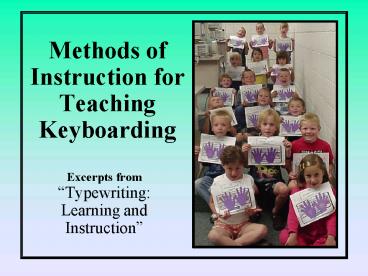Methods of Instruction for Teaching Keyboarding - PowerPoint PPT Presentation
1 / 23
Title:
Methods of Instruction for Teaching Keyboarding
Description:
In learning any psychomotor skill, an essential component of the learning ... of skill-learning research and studies of time and motion in human performance, ... – PowerPoint PPT presentation
Number of Views:29
Avg rating:3.0/5.0
Title: Methods of Instruction for Teaching Keyboarding
1
Methods of Instruction for Teaching Keyboarding
- Excerpts fromTypewriting Learning and
Instruction
2
Attitudes Toward Learninga New Skill
- Interest and a desire to learn
- Duty or requirement
- Evident discomfort
3
Progression of Learning
StudentSelf-Guidance
Teacher/StudentGuidance
Complete Teacher Guidance
4
In learning any psychomotor skill, an essential
component of the learning process is an active
teacher who observes and evaluates the process of
learning and provides feedback in the form of
correctives (comments and demonstrations) to help
the learner improve. Typewriting Learning and
Instruction
5
Keyboarding is learned through appropriate and
purposeful practice.
The keyboarding teacher is of paramount
importancein guiding that practice!
6
Keyboarding is a cumulative skillwhat can be
effectively learned at one level depends heavily
upon what has been learned earlier. If hunt n
peck habits become ingrained, it becomes much
more difficult to develop a competent
keyboarding skill. You need that basic
foundation early on.
Desert News, April 5,
1999
7
Keyboarding Learning Phases
Phase 1 Students learn the nature of the
keying task.
Phase 2 Students improve reading-for- keying
skill.
8
Keyboarding Learning Phases
Phase 3 Students increase in response
stability, accuracy of stimulus, and
spontaneity of responses.
9
It is the responsibility of the keyboarding
teacher to presentthe new learning in a positive
manner and show its relevance in students
lives.
10
Keyboarding Software
The complexity of teaching keyboarding requires
an extensive and extremely well-written software
program. No software program has been
shown to be superior to capable, live
keyboarding instruction. Who Should Teach
Keyboarding and When Should it Be Taught,
Margaret J. Erthal, Business Education
Forum, Oct. 1998
11
Keyboarding Software
You would not sit a child down at a piano and use
a software package to teach piano playing.
Similarly, children are taught to play sports
with a coach and much guided practice. The coach
provides motivation, reinforcement, and
corrective action.
12
Effective Keyboarding Teachers
- Demonstrate proper keyboarding competence.
- Demonstrate the subskills that make up the total
skill.
13
Demonstration is perhaps the most important
single method of providing instruction in
keyboarding An ounce of showing is worth a
pound of discussing and A gram of demonstration
is worth a kilogram of discovery for
trial-and-error methods are uneconomical and
inefficient in complex skill learning.
Typewriting Learning and Instruction
14
Effective Keyboarding Teachers
- Determine student abilities and competencies
through observation. - Capitalize on student strengths to aid in
overcoming any weaknesses. - Provide regular, positive reinforcement,
feedback, and suggestions.
15
From the findings of skill-learning research and
studies of time and motion in human performance,
technique or form has come to be considered a
prerequisite to skilled performance of motor
tasks. Typewriting Learning and Instruction
16
Effective Keyboarding Teachers
- Evaluate the process not the product.
- Minimize the negative aspects of competition.
- Manipulate the goals of learning activities so
that appropriate tension results. - Watch for evidence of excessive anxiety.
17
Effective Keyboarding Teachers
- Reduce excessive anxiety by
- Encouraging self-competitiondont pit students
against each other! - Ensuring that group competitions are FUN rather
than stressful. - Having students set their own goals.
18
Effective Keyboarding Teachers
- Reduce excessive anxiety by
- Keeping a folder for each student rather than a
grade book that indicates only relative
performance. - Providing a variety of situations where
ALL students experience success.
19
Keyboarding and Reading
- Both are automatic skills (see then do).
- Both are based on
- Instant Letter Recognition
- Instant Word Recognition
- Not only can elementary students learn to type,
but those who do type improve their language arts
skills.
(Wood Freeman, 1931 and
Erickson, 1959) - They compliment each other!
20
Research Shows
- Children with good keying skills are able to
- Compose faster,
- Produce documents with a neater appearance,
- Demonstrate improved language arts skills.
- Have higher self esteem.
21
Research Shows
Keyboarding facilitates skill development in
writing, spelling and grammar Students who can
keyboard are not only faster but also more
imaginative. They are free to think about
composing text or copying material rather than
constantly trying to find their place.
22
In just three short months of keyboarding twice
a week a teacher in the Salt Lake City elementary
schools noticed benefits. She reported that the
kids are more careful about the beginnings and
endings of their sentences. They recognize
structure better and pay more attention to
details. In addition, she found that the
keyboarding program instilled her students with
confidence in using a microcomputer.
Salt Lake Tribune,
December 1983
23
One must use the correct technique to get the
correct spin on the curve ball or the ball will
not curve. Thus the student must work on the
technique until the response becomes automated. A
pitcher can throw the curve at the appropriate
speed, and it will curve. The pitcher does not
think about the placement of the curve ball or
the accuracy of the curve ball until the
technique and the speed portions have become
automated. Typewriting/Keyboarding
Instruction in Elementary Schools
Lloyd Bartholome, Utah
State University































